Touch Panel
Wir sorgen für mehr Transparenz
Hochwertige Touch Panels werden bei anspruchsvollen Anwendungen als dezentrale Bedien- und Anzeigeneinheiten sowie zur Darstellung und Optimierung der Prozesse eingesetzt. Sie sind in skalierbaren Diagonalen und für nahezu jede Montagesituation verfügbar und mit kapazitivem Touch sowie hochwertigem Display ausgestattet. Unterschiedliche Schnittstellen stehen zur Kommunikation mit der Steuerung und den Peripheriegeräten sowie übergeordneten Leitsystemen zur Verfügung.
- Hochwertige Visualisierung
Hochauflösendes Display mit weitem Blickwinkel bietet maximale Bildqualität.
- Low-Power bis High-Performance
Skalierbar in Displaygrösse und Prozessorleistung.
- Software-basierte Lösung
Mit unseren Tools die Visualisierung einfach und schnell umsetzen.
- Einfache Konfiguration
Panels schnell und einfach an Kundenbedürfnisse anpassen, dank ausgefeilter Software Tools.
- Mehrsprachigkeit
Software Tools mit einem umfassenden Spektrum an Sprachunterstützung.
- Langfristige Verfügbarkeit
Investitionssicherheit dank Form, Fit and Function.
- Lifecycle-Management
Professionelle Begleitung für die Unterstützung eines langen Produktlebenszyklus.
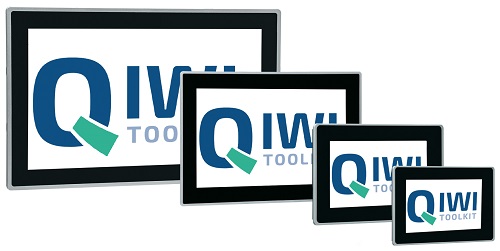
WP Web Panel 4X, 6X
Innovative Web Panel mit QIWI Software Toolkit
- Arm® i.MX8M Mini 4 Core 1.6 GHz
- Arm® i.MX8M Plus 4 Core 1.6 GHz
- Höhere Leistung mit moderner Arm® Quad Core CPU
Zubehör
- Kein Zubehör
Software
- Embedded Linux (Yoctro Distribution)
- QIWI Toolkit
- Optional CODESYS® SoftSPS
Technische Daten
| Funktion | WP 4x mit Arm® i.MX8M Mini | WP 6x mit Arm® i.MX8M Plus |
| Touch | ||
| PCAP Multitouch, bündige Glasoberfläche | ||
| Prozessor | ||
| Arm® i.MX8M Mini 4 Core 1.6 GHz | Arm® i.MX8M Plus 4 Core 1.6 GHz | |
| Speicher | ||
| RAM | 1 GB DDR4 (bis zu 2 GB) | 1 GB DDR4 (bis zu 2 GB) |
| FLASH | 4 GB eMMC (bis zu 32 GByte) | 4 GB eMMC (bis zu 32 GB) |
| microSD-Karten-Slot (bis zu SDXC-Format) | microSD-Karten-Slot (bis zu SDXC-Format) | |
| Schnittstellen | ||
| 2x USB 2.0 (Host) 1x Ethernet (10/100/1000) | 2x USB 2.0 (Host) 1x Ethernet (10/100/1000) | |
| Spannungsversorgung | ||
| 24 V DC ±20 % | ||
| EMV | ||
| EN 61000-6-2 (Immunität), EN 61000-6-4 (Emission) | ||
| Zertifizierung | ||
| CE (UL, cUL geplant) | CE, (UL/cUL geplant) | |
| Sicherheitsglas/Mechanisch | ||
| Frontblende IP65 aus Aluminum, Rückseite IP20 aus Edelstahl/Befestigungselemente für die schnelle Montage (Hoch- oder Querformat) | ||
| Umgebung | ||
| Temperaturbereich | 0 °C…+55 °C (optional -20 °C ... +55 °C) | |
| Kühlung | Lüfterlos | |
| Schock | EN 60068-2-27: 15G 11ms (halb Sinusstoss) | |
| Vibration | EN 60068-2-6: 10-500Hz 1G/3 Achse | |
| Umgebungstemperatur | 10 % - 90 %, nicht kondensierend | |
| Software | ||
| Betriebssystem | Embedded Linux (Yocto Distribution) | Embedded Linux (Yocto Distribution) |
| Browser | Chromium basiert HTML-5 | Chromium basiert HTML-5 |
| Zusätzliche Informationen | QIWI Toolkit, optimierter Browser, einfache Konfiguration und breite Funktionspalette | |
| Optionen (Weitere Optionen auf Anfrage) | ||
| 2x Ethernet, 1x RS232, 1x WIFI USB Dongle, entspiegeltes Display, Kundenlogo im Display-Rahmen | PoE (Power over Ethernet), 2x GBit Ethernet, 1x RS485, 2x GPO, WIFI USB Dongle, entspiegeltes Display, Kundenlogo im Display-Rahmen | |
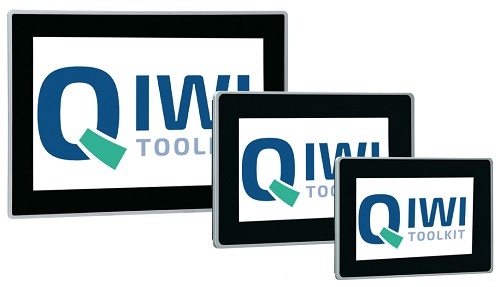
WP Web Panel 7", 10", 15"
Innovative Web Panel mit QIWI Software Toolkit
- Arm® i.MX6 1 oder 2 Cores 800 MHz
- Arm® i.MX8M Mini 4 Cores 1,6 GHz
- Intel Atom® E3800 2 Cores 1,33 GHz/4 Core 1,91 GHz
Zubehör
- Kein Zubehör
Software
- Embedded Linux (Yocto Distribution)
- Embedded Linux (Debian Distribution) für IntelAtom
- QIWI Toolkit
- Optional iniNET MicroBrowser Spider Control
- Optional CODESYS® SoftSPS
Technische Daten
| Funktion | WP 3x mit Arm® i.MX6 | WP 4x mit Arm® i.MX8M Mini | WP 5x mit Intel Atom® E3800 |
| Touch | |||
| PCAP Multitouch, bündige Glasoberfläche | |||
| Prozessor | |||
| Arm® i.MX6 1 oder 2 Cores 800 MHz | Arm® i.MX8M Mini 4 Cores 1.6 GHz | Intel Atom® E3800 2 Core 1.33 GHz / 4 Core 1.91 GHz | |
| Speicher | |||
| RAM | 1 GB DDR3 (bis zu 2 GB) | 1 GB DDR4 (bis zu 2 GB) | 2 GB DDR3 (bis zu 8 GB) |
| FLASH | 512 MB NAND Flash | 4 GB eMMC (bis zu 32 GB) | 16 GB eMMC (bis zu 32 GB) |
| microSD-Karten-Slot | microSD-Karten-Slot | microSD-Karten-Slot | |
| Schnittstellen | |||
| 2x USB 2.0 (Host) 1x Ethernet (10/100) | 2x USB 2.0 (Host) 1x Ethernet (10/100/1000) | 2x USB 2.0 (Host) 1x Ethernet (10/100/1000) | |
| Spannungsversorgung | |||
| 24 V DC ±20 % | |||
| EMV | |||
| EN 61000-6-2 (Immunität), EN 61000-6-4 (Emission) | |||
| Zertifizierung | |||
| CE | CE, (UL/cUL geplant) | CE | |
| Sicherheitsglas/Mechanisch | |||
| Frontblende IP65 aus Aluminum, Rückseite IP20 aus Edelstahl/Befestigungselemente für die schnelle Montage (Hoch- oder Querformat) | |||
| Umgebung | |||
| Temperaturbereich | 0 °C…+55 °C | ||
| Kühlung | Lüfterlos | ||
| Schock | EN 60068-2-27 | ||
| Vibration | EN 60068-2-6 | ||
| Umgebungstemperatur | 10 % - 90 % @39 °C, nicht kondensierend | ||
| Software | |||
| Betriebssystem | Embedded Linux (Yocto) | Embedded Linux (Yocto) | Embedded Linux (Debian) |
| Browser | Chromium based HTML-5 oder MicroBrowser (IniNet) | Chromium based HTML-5 | Chromium based HTML-5 |
| Zusätzliche Informationen | QIWI Toolkit, optimierter Browser, einfache Konfiguration und breite Funktionspalette | ||
| Optionen (Weitere Optionen auf Anfrage) | |||
| Edelstahl Frontseite, 2x Ethernet, 1x RS232, 1x RS485 WIFI USB Dongle | Edelstahl Frontseite, 2x Ethernet, 1x RS232, WIFI USB Dongle | Edelstahl Frontseite, 2x Ethernet, 1x RS232, 1x RS485 WIFI USB Dongle | |
| Display Informationen | |||
| Display Grösse | |||
| 7.0” | 10.1” | 15.6” | |
| Auflösung | |||
| 1024 x 600 | 1280 x 800 | 1366 x 768 | |
| Typ | |||
| Opt. bond | Opt. bond | Air-gap | |
| Format | |||
| 17 : 10 | 16 : 10 | 16 : 9 | |
| Helligkeit | |||
| 450 cd/m² | 430 cd/m² | 400 cd/m² | |
| Blickwinkel | |||
| 85° / 85° / 85° / 85° | 80° / 80° / 80° / 80° | 85° / 80° / 85° / 85° | |
| Farben | |||
| 16,7 Millionen | 16,7 Millionen | 16,7 Millionen | |
| Abmessungen WP3x / WP 4x | |||
| 200 x 132 x 48 | 265 x 187 x 41 | 405 x 254 x 60 | |
Download
WP_Web_Panel_3x_4x_5x_Factsheet_DE.pdf
QIWI_Software_Toolkit_Factsheet_DE.pdf
General-Safety-Instructions.pdf
Web-Panel_WP-70_iMX6_Handbuch_901831A_DE.PDF
Web-Panel_WP-101_iMX6_Handbuch_901841A_DE.PDF
Web-Panel_WP-156_iMX6_Handbuch_901881A_DE.PDF
Web-Panel_WP-xxx_iMX8_Handbuch_902090B_DE.PDF
Quickstart_Guide_Web-Panel_WP-3x__4x__5x_902190A_EN.PDF
Video
- Performance compare (1) - QIWI Toolkit(1) - offers a performance optimized
- Easy onfiguration (2) - QIWI Toolk
- Quick setup (3) - QIWI Toolkit (3) - configure the device as a web brower, fast and easy
- Device Security (4) - QIWI Toolkit (4) - increased security of the web in terms of maleware and manipulation
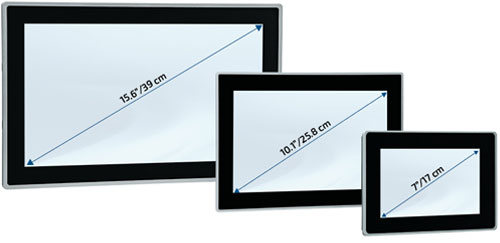
CP Control Panel 6x
Control Panel 6x mit vielfältiger Konnektivität
- NXP Arm® i.MX8M Plus 4 Core, 1,6 GHz
- 1 GB DRAM DDR3L
- IPS, optisch gebondet
Zubehör
- kein Zubehör
Software
- Embedded Linux (Yocto Distribution)
- Optional CODESYS® SoftSPS
Technische Daten
| CP-70 | CP-101 | CP-156 | CP-156FHD | |
| Display | ||||
| IPS, optisch gebondet, siehe untenstehende Tabelle | ||||
| Touch | ||||
| Technologie | PCAP, glänzende Glasoberfläche | |||
| Prozessor | ||||
| CPU | NXP Arm® i.MX8M Plus Quad Core, 1,6 GHz | |||
| Speicher/Ablage | ||||
| DRAM DDR3L | 1 GByte, gelötet (bis zu 4 GByte) | |||
| eMMC | 4 bis 32 GByte | |||
| NOR FLASH | 2 MByte (16 MByte) | |||
| FRAM | 128 kByte (bis zu 512 kByte) | |||
| SD-Karte | microSD-Karten-Slot (bis zu SDXC-Format) | |||
| Schnittstellen | ||||
| USB | 2x USB 2.0 (Host) | |||
| Ethernet | 2x Ethernet (10/100/1000) unabhängig, 1x TSN-fähig | |||
| CAN | 1x CAN FD (isoliert), optional: 2x CAN FD | |||
| Serielle Schnittstellen | 1x RS232, 1x RS485 (isoliert), optional: 2x RS485 | |||
| Steckbare Erweiterungen | optional: GPIO, HDMI, SPI, i²C, MIPI CSI 4-lane, Audio, M.2 Slot (Key E, B) | |||
| Weitere Features | ||||
| Sicherheit | TPM | |||
| Echtzeituhr | RTC mit SuperCAP (>20 Tage) | |||
| Mechanik | ||||
| Konstruktion | Front IP65 aus Aluminium, Rückseite IP20 aus Edelstahl/Aluminium | |||
| Kühlung | Lüfterlos | |||
| Befestigung | Befestigungselemente für eine einfache und schnelle Schaltschrankmontage | |||
| Umgebungsbedingungen | ||||
| Zertifizierung | CE (UL/cUL geplant) | |||
| Versorgung | 24 V DC ±20 % | |||
| EMV | EN 61000-6-2 (Immunität), EN 61000-6-4 (Emission) | |||
| Temperaturbereich | 0 °C…+55 °C (optional -20 °C...+55 °C) | |||
| Lagertemperatur | -20 °C…+70 °C | |||
| Umgebungstemperatur | 10 %-90 % @39 °C, nicht kondensierend | |||
| Höhe | Bis zu 9.800 ft (3000 m) | |||
| Software | ||||
| Betriebssystem | Embedded Linux (Yocto Distribution) | |||
| SOFTSPS (Optional) | CODESYS® V3 | |||
| Protokolle (Optional) | EtherCAT, Modbus TCP/RTU, Profinet, Ethernet IP, CANopen, OPC UA, IIoT Libraries (MQTT, HTTPS, Azure, AWS, Google) | |||
| Display Informationen | ||||
| Display-Grösse | ||||
| CP-70: 7.0" | CP-101: 10.1" | CP-156: 15.6" | CP-156FD: 15,6" | |
| Auflösung | ||||
| 1024 x 600 | 1280 x 800 | 1366 x 768 | 1920 x 1080 | |
| Format | ||||
| 17 : 10 | 16 : 10 | 16 : 9 | 16 : 9 | |
| Helligkeit | ||||
| 450 cd/m² | 420 cd/m² | 400 cd/m² | 600 cd/m² | |
| Abmessungen | ||||
| 200 x 132 x 48 | 265 x 187 x 41 | 405 x 254 x 60 | 405 x 254 x 60 | |
| Blickwinkel | ||||
| 85° / 85°/ 85° / 85° | 85° / 85°/ 85° / 85° | 85° / 85°/ 85° / 85° | 85° / 85°/ 85° / 85° | |
| Farben | ||||
| 16,7 Millionen | 16,7 Millionen | 16,7 Millionen | 16,7 Millionen | |
| Gewicht | ||||
| 0,83 kg | 1,3 kg | 3,5 kg | 3,5 kg | |
| Verbrauch | ||||
| 5,5 VA | 8,9 VA | 16,8 VA | 20 VA | |

CP Control Panel 7", 10", 15"
Control Panel mit skalierbarer Performance
- NXP Arm® i.MX6 1-2 Cores, 800 MHz
- 1 GB DRAM DDR3L
- Kapazitiver Multi-Touch
Zubehör
- Kein Zubehör
Software
- Embedded Linux (Yocto Distribution)
- Optional CODESYS® SoftSPS
Technische Daten
| CP-70 | CP-101 | CP-156 | |
| Display | |||
| Siehe untenstehende Tabelle | |||
| Touch | |||
| Technologie | PCAP, glänzende Glasoberfläche | ||
| Prozessor | |||
| CPU | NXP Arm® i.MX6 1-2 Cores, 800 MHz | ||
| Speicher/Ablage | |||
| DRAM DDR3L | 1 GByte, gelötet (bis zu 2 GByte) | ||
| eMMC | (4 bis 16 GByte) | ||
| NAND/NOR FLASH | 512 MByte (256 MByte) / 1 MByte (bis zu 16 MByte) | ||
| SRAM/FRAM | 128 kByte (bis zu 512 kByte)/ (bis zu 512 kByte) | ||
| SD-Karte | microSD-Karten-Slot, austauschbar (bis zu 32 GByte SDHC) | ||
| Schnittstellen | |||
| USB | 2x USB 2.0 (Host) | ||
| Ethernet | 2x Ethernet (10/100) unabhängig | ||
| CAN | 1x CAN (isoliert) | ||
| Serielle Schnittstellen | 2x RS232, 1x RS485 (isoliert) | ||
| Steckbare Erweiterungen | GPIO, HDMI, SPI, i²C | ||
| Mechanik | |||
| Konstruktion | Front IP65 aus Aluminium, Rückseite IP20 aus Edelstahl | ||
| Kühlung | Lüfterlos | ||
| Befestigung | Befestigungselemente für eine einfache und schnelle Schaltschrankmontage | ||
| Umgebungsbedingungen | |||
| Zertifizierung | CE | ||
| Leistung | 24 V DC ±20 % | ||
| EMV | EN 61000-6-2 (Immunität), EN 61000-6-4 (Emission) | ||
| Temperaturbereich | 0 °C…+55 °C | ||
| Lagertemperatur | -20 °C…+70 °C | ||
| Umgebungstemperatur | 10 %-90 % @39 °C, nicht kondensierend | ||
| Höhe | Bis zu 6.500 ft (2000 m) | ||
| Software | |||
| Betriebssystem | Embedded Linux (Yocto) | ||
| SOFTPLC (Optional) | CODESYS V3 | ||
| Protokolle (Optional) | EtherCAT, Modbus TCP/RTU, Profinet, Ethernet IP, CANopen, OPC UA | ||
| Display Informationen | |||
| Display-Grösse | |||
| CP-70: 7.0" | CP-101: 10.1" | CP-156: 15.6" | |
| Auflösung | |||
| 1024 x 600 | 1280 x 800 | 1366 x 768 | |
| Format | |||
| 17 : 10 | 16 : 10 | 16 : 9 | |
| Helligkeit | |||
| 450 cd/m² | 420 cd/m² | 400 cd/m² | |
| Abmessungen | |||
| 200 x 132 x 48 | 265 x 187 x 41 | 405 x 254 x 60 | |
| Blickwinkel | |||
| 85° / 85°/ 85° / 85° | 85° / 85°/ 85° / 85° | 85° / 85°/ 85° / 85° | |
| Farben | |||
| 16,7 Millionen | 16,7 Millionen | 16,7 Millionen | |
| Gewicht | |||
| 0,83 kg | 1,3 kg | 3,5 kg | |
| Verbrauch | |||
| 5,5 VA | 8,9 VA | 16,8 VA | |

Display-Line 7-Zoll i.MX8M Mini
Touch Panel 7"
- NXP i.MX8M Mini 4x Arm® Cortex®-A53 @1,6 GHz
- 1x Arm® Cortex®-M4 @400 MHz
- 4 GB LPDDR4-RAM
Zubehör
- AC Connector Set
- AC Power Supply
- AC microSD
Software
- Embedded Linux (Yocto Distribution)
- Optional CODESYS® SoftSPS
Technische Daten
| Mensch-Maschine-Interface | |||
| Funktion | Standard-Bestückung | Optionen | |
| Front | Aluminium-Frontrahmen | ||
| Display | 7" IPS, 1024 x 600 Pixel 450 cd/m² | ||
| Touch | PCAP Multitouch | ||
| Allgemein | |||
| Spannungsversorgung | 24V DC ±20 % | ||
| Stromverbrauch | Linux running <6 W | ||
| RTC-Pufferung | CR1220 | ||
| Debug | 1x Konsole | ||
| Abmessung (BxHxT) | Alu-Front:200,1 x 131,9 x 46,5 mm | ||
| Betriebstemperatur | 0 °C…+55 °C | ||
| Schutzart | Frontseitig IP65, Rückseite IP20 | ||
| CPU-Einheit | |||
| CPU | NXP i.MX8M Mini 4x Arm® Cortex®-A53 @1,6 GHz, 1x Arm® Cortex®-M4 @400 MHz | ||
| Speicher | |||
| LPDDR4 | 4x GB | 1x GB, 2x GB | |
| NOR-FLASH | 2x MB | ||
| eMMC | 32 GB | 4 GB bis zu 64 GB | |
| SD-Karte | 1x microSD-Karten-Slot | ||
| nv Memory | 8 kB (64 kB) EERAM | ||
| Kommunikation | |||
| Ethernet | 1x 1 Gbit/s, 1x 10/100 Mbit/s | ||
| USB | 2x 2.0 Host, 1x 2.0 OTG | ||
| Seriell | 1x RS232, 1x RS485 | ||
| CAN | 1x CAN 2.0 B | ||
| DIO | 4x DIO (24 V/bis zu 800 mA) | ||
| Software | |||
| Bootloader | U-Boot | ||
| Betriebssystem | Embedded Linux (Yocto Distribution) | ||
| RTC | 5ppm Genauigkeit | ||

Display-Line i.MX6 ULL
Touch Panel im Format 5"
- NXP i.MX6 ULL 1x Arm® Cortex®-A7 @800 MHz
- Glas-Front, rahmenlos, 5“ TFT
- 512 MB DDR3-RAM
Zubehör
- AC Connector Set
- AC Power Supply
- AC microSD
Software
- Embedded Linux (Yocto Distribution)
- Optional CODESYS® SoftSPS
Technische Daten
| Mensch-Maschine-Interface | |||
| Funktion | Standard-Bestückung | ||
| Glas-Front | Rahmenlos | ||
| Display | 5“ TFT, 800 x 480 Pixel, 450 cd/m² | ||
| Touch | PCAP Multitouch | ||
| Allgemein | |||
| Spannungsversorgung | 24 V DC ±20 % | ||
| Stromverbrauch | Linux running <1,5 W | ||
| RTC-Pufferung | CR1220 | ||
| Debug | 1x Konsole | ||
| Abmessungen (BxHxT) | 130 x 89 x 38 mm | ||
| Einbaumaß (BxH) | 126 x 82 mm | ||
| Betriebstemperatur | 0 °C...+60 °C | ||
| Schutzart | Frontseitig IP65 | ||
| CPU-Einheit | |||
| CPU | NXP i.MX6 ULL 1x Arm® Cortex®-A7 @800 MHz | ||
| Speicher | |||
| DDR3-RAM | 512 MB | ||
| NAND-FLASH | 512 MB | ||
| NOR-FLASH | 1 MB | ||
| eMMC | 4 GB | ||
| SD-Karte | 1x microSD-Karten-Slot | ||
| nv Memory | 8 kByte nvSRAM | ||
| Kommunikation | |||
| Ethernet | 2x 10/100 Mbit/s | ||
| USB | 2x 2.0 Host, 1x 2.0 OTG | ||
| Seriell | 1x RS232, 1x RS485 | ||
| CAN | 1x CAN 2.0 | ||
| DIO | 2x DIO (24 V/bis zu 800 mA) | ||
| AIO | 2x AIN (0...24 V) | ||
| Software | |||
| Bootloader | U-Boot | ||
| Betriebssystem | Embedded Linux (Yocto Distribution) | ||
| RTC | 5ppm Genauigkeit | ||
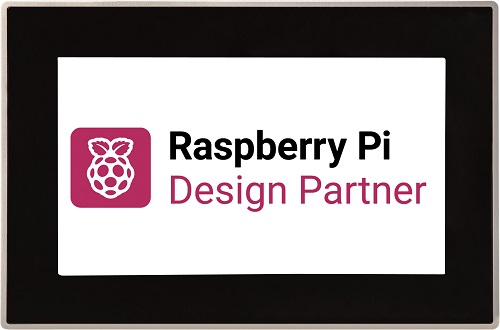
Display-Line Pi-Tron CM4
Touch Panel 7" Format / verfügbar ab Q2-2024
- Broadcom BCM2711 4x Arm® Cortex®- A72 @1,5 GHz
- 7" IPS Multitouch, 1024 x 600 Pixel 450cd/m2
- Aluminium-Frontrahmen, Front IP65
Software
- Raspian Linux
Technische Daten
| Mensch-Maschine-Interface | |||
| Funktion | Standard-Bestückung | Optionen | |
| Front | Aluminium-Frontrahmen | ||
| Display | 7" IPS, 1024 x 600 Pixel 450 cd/m² | ||
| Touch | PCAP Multitouch | ||
| Allgemein | |||
| Spannungsversorgung | 24V DC ±20 % | ||
| Stromverbrauch | Linux running 7,2 W - 13,4 W | ||
| RTC-Pufferung | CR2032 | ||
| Debug | 1x Konsole | ||
| Abmessung (BxHxT) | Alu-Front:200,1 x 131,9 x 46,5 mm | ||
| Betriebstemperatur* | 0 °C…+55 °C | ||
| Schutzart | Frontseitig IP65, Rückseite IP20 | ||
| CPU-Einheit | |||
| CPU | Broadcom BCM2711, 4x Arm® Cortex®-A72 @1,5 GHz, 3D Video Engine | ||
| Speicher | |||
| LPDDR4 | 2x GB | 1x GB, 4x GB, 8 GB | |
| eMMC | Compute Module CM4: 16 GB | CM4: lite/8 GB/32 GB (lite: ohne eMMC nur mit microSD-Karte) | |
| SD-Karte | CM4 lite: 1x microSD-Karten-Slot für Betriebssystem, CM4 8GB, 16 GB, 32 GB: 1x micro SD-Karten Slot für Daten | ||
| EEPROM* | 4 kB (32kb) | ||
| Kommunikation | |||
| Ethernet | 1x 1 Gbit/s, 1x 10/100 Mbit/s | ||
| USB | 2x 2.0 Host, 1x 2.0 OTG nur um den eMMC zu programmieren | ||
| WLAN/Bluetooth® | Optional 2,4 GHz/5,0 GHz, IEEE 802.11 b/g/n/ac wireless BT 5.0, BLE | ||
| Seriell | 1x RS232, 1x RS485 | ||
| CAN | 1x CAN 2.0B/FD | ||
| DIO | 4x DIO (24 V/bis zu 800 mA) | ||
| Display | |||
| LCD Interface | 1x HDMI 2.0 (bis zu 4Kp60 - HDMI0) | ||
| Software | |||
| Betriebssystem | Raspian Linux | ||
| RTC | ± 1ppm Genauigkeit | ||
| *Vorläufige Angaben | |||
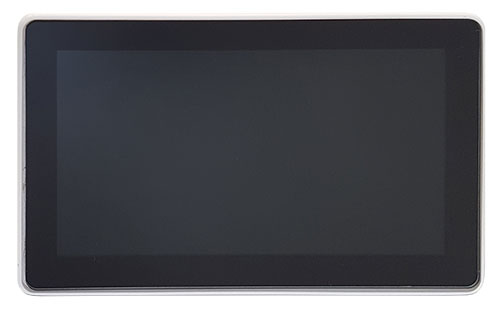
TM Touch-Monitor
Individuelle Touch-Monitor Lösungen mit HDMI Anschluss
- Von 5“ bis 15.6“
- HDMI Anschluss für verschiedene Auflösungen inklusive Scaling
- Kundenspezifische Gehäuse- und Montagesysteme
Zubehör
- Kein Zubehör
Software
- Keine Software
Technische Daten
| Touch-Monitor | |
| Display | |
| Grösse | 5" - 15." Displays (breites Format) |
| Grafik Prozessor | Realtek RTD2483 |
| Touch | |
| Technologie | PCAP, Multitouch mit Glasoberfläche |
| Schnittstellen | |
| HDMI | HDMI Typ A, HDMI Anschluss mit Unterstützung für verschiedene Auflösungen. Bildskalierung kann optional aktiviert werden. |
| Touch | USB 2.0 Typ B, agiert als HID Gerät |
| Spannungsversorgung | 24 V DC ±20 % |
| Mechanik | |
| Gehäusedesign | Kundenspezifisches Gehäusedesign für den Schaltschrankeinbau oder Stand-Alone-Version für VESA- oder Tragarmmontage, je nach Kundenwusch |
| Umgebung | |
| Zertifizierung | Gemäss Kundenanforderung |
| Temperaturbereich | 0 °C …+50 °C |
| Storage Temperatur | -25 °C …+60 °C |
| Umgebungstemperatur | 5 % - 95 % nicht kondensierend |
| OEM Branding | |
| Front | Optionales OEM Logo auf dem Deckglas |
| Bezeichnung | Optionales OEM-Typenschild gemäß Kundenspezifikation |





